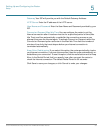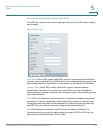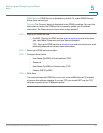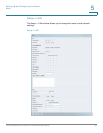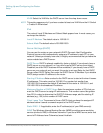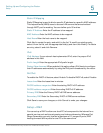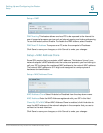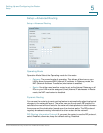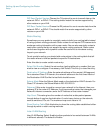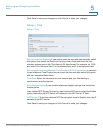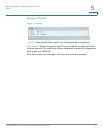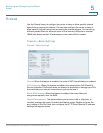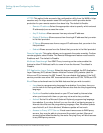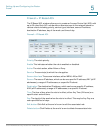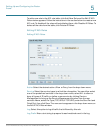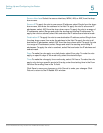
Setting Up and Configuring the Router
Setup
Cisco RVS4000 Security Router with VPN Administrator Guide 43
5
RIP Send Packet Version Choose the TX protocol to use to transmit data on the
network: RIPv1 or RIPv2. This setting should match the version supported by
other routers on your LAN.
RIP Recv Packet Version Choose the RX protocol to use to receive data from the
network: RIPv1 or RIPv2. This should match the version supported by other
routers on your LAN.
Static Routing
Sometimes you may prefer to use static routes to build your routing table instead
of using dynamic routing protocols. Static routes do not require CPU resources to
exchange routing information with a peer router. You can also use static routes to
reach peer routers that do not support dynamic routing protocols. Static routes
can be used together with dynamic routes. Be careful not to introduce routing
loops in your network.
To set up static routing, you should add route entries in the routing table that tell
the router where to forward packets to specific IP destinations.
Enter this data to create a static route entry:
Select Set Number Select the set number (routing table entry number) that you
wish to view or configure. If necessary, click Delete This Entry to clear the entry.
Destination IP Address Enter the network address of the remote LAN segment.
For a standard Class C IP domain, the network address is the first three fields of
the Destination LAN IP, while the last field should be zero.
Subnet Mask Enter the Subnet Mask used on the destination LAN IP domain. For
Class C IP domains, the Subnet Mask is 255.255.255.0.
Gateway If this router is used to connect your network to the Internet, then your
gateway IP is the router’s IP Address. If you have another router that manages your
network’s Internet connection, enter the IP Address of that router instead.
Hop Count This value gives the number of nodes that a data packet passes
through before it reaches its destination. A node is any device on the network,
such as switches, PCs, etc. The maximum hop count value is 16.
Show Routing Table Click this button to show the routing table established either
through dynamic or static routing methods.
Inter-VLAN Routing
Inter-VLAN Routing Select Enable to allow packets to be routed between VLANs
in different subnets. The default is Enable.



